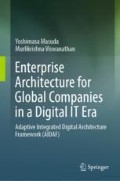Abstract
The purpose of this chapter is to propose an “Adaptive Integrated Digital Architecture Framework—AIDAF” to meet the requirements of the digital transformation in relation to the above agility-related aspects. The proposed EA framework should support an IT strategy promoting cloud/mobile IT/Digital IT, based on what our prior research suggested. Also, we show the recommended EA artifacts in AIDAF, compared with Zachman Framework and DODAF, for use with the EA3 Cube Framework. Moreover, we propose an architecture assessment model, global communication/knowledge management model, and Risk Management model related to the above AIDAF in this chapter. In later chapters, we will show a case of EA framework building by the global company.
Access this chapter
Tax calculation will be finalised at checkout
Purchases are for personal use only
References
Bernard, S. (2006). Using enterprise architecture to integrate strategic, business, and technology planning. Journal of Enterprise Architecture, 2, 11–28.
Rogers, E. M. (1992). Multimedia technology: The new media in society (T. Yasuda, Trans.). Kyoritsu Publishing.
Federal Enterprise Architecture Framework. (2013). Version 2.
Franke, U., Hook, D., Konig, J., Lagerstrom, R., Narman, P., Ullberg, J., Gustafsson, P., & Ekstedt, M. (2009). EAF2—a framework for categorizing enterprise architecture frameworks. In Proceedings of the 10th ACIS International Conference on Software Engineering, Artificial Intelligences, Networking and Parallel/Distributed Computing (pp. 327–332). IEEE Computer Society.
Gill, A. Q. (2014). Applying agility and living service systems thinking to enterprise architecture. International Journal of Intelligent Information Technologies, 10(1), 1–15.
Gill, A. Q. (2015). Adaptive cloud enterprise architecture. Intelligent Information Systems (Vol. 4). Australia: University of Technology.
Gill, A. Q., Smith, S., Beydoun, G., & Sugumaran, V. (2014). Agile enterprise architecture: A case of a cloud technology-enabled government enterprise transformation. In Proceedings of the 19th Pacific Asia Conference on Information Systems (PACIS 2014) (pp. 1–11). United States.
Aldrich, H. (2007).Organizations evolving [Soshiki Shinkaron]. Toyo Keizai Inc.
Information Systems Audit and Control Association—ISACA (2012). COBIT5: A business framework for the governance and management of enterprise IT.
Martin, J. N. (2016). Overview of an emerging standard on architecture processes—ISO/IEC 42020. In The 26th Annual INCOSE International Symposium (IS 2016),
Martin, J. N. (2017). Overview of an emerging standard on architecture evaluation—ISO/IEC 42030. In The 27th Annual INCOSE International Symposium (IS 2017). Adelaide, Australia.
Kanbe M., Yamamoto, S., & Ohta, T. (2010). A proposal of TIE model for communication in software development process. In K. Nakakoji, Y. Murakami, & E. McCready (Eds.), JSAI-is AI, LNAI 6284 (pp. 104–115). Berlin, Heidelberg: Springer.
Masuda, Y., Shirasaka, S., Yamamoto, S. & Hardjono, T. (2017a). 7 1. An adaptive enterprise architecture framework and implementation: Towards global enterprises in the era of cloud/mobile IT/digital IT. International Journal of Enterprise Information Systems. IGI Global, 13, 3, 1–22. https://doi.org/10.4018/ijeis.2017070101.
Masuda, Y., Shirasaka, S., Yamamoto, S., & Hardjono, T. (2017b). Proposal of GDTC model for global communication on enterprise portal—KES 2017. In 21st International Conference on Knowledge-Based and Intelligent Information & Engineering Systems, France, September in 2017 (pp. 1178–1188). Journal of Procedia Computer Science, Elsevier.
Masuda, Y., Shirasaka, S., Yamamoto, S., & Hardjono, T. (2017c). Risk management for digital transformation in architecture board: A case study on global enterprise. In EAIS International Conference 2017, 6th IIAI International Congress on Advanced Applied Informatics (IIAI-AAI), IEEE Conference Proceedings (pp. 255–262).
Masuda, Y., Shirasaka, S., Yamamoto, S., & Hardjono, T. (2018). Architecture board practices in adaptive enterprise architecture with digital platform: A case of global healthcare enterprise. International Journal of Enterprise Information Systems. IGI Global, 14(1), 1–20.
Ross, J.W., Weill, P., & Robertson, D. C. (2006). Enterprise architecture as strategy—creating a foundation for business execution, Harvard Business Review Press.
Sowa, J. F., & Zachman, J. A. (1992). Extending and formalizing the framework for information systems architecture. IBM Systems Journal, 31(3), 590–616.
The Open Group. (2009). Content metamodel. Retrieved October 15, 2010, from http://www.open-group.org/architecture/togaf9-doc/arch/chap34.html.
The Open Group. (2017). Open Group Standard—The Open Group IT4IT™ reference architecture, version 2.1.
TOGAF® Version 9.1. (2011). An open group standard. Retrieved from www.opengroup.org/togaf.
UK Ministry of Defence. (2010a). MOD architecture framework (MODAF). Retrieved October 22, 2010 from http://www.mod.uk/DefenceInternet/AboutDefence/WhatWeDo/InformationManage-ment/MODAF/ModafDetailedGuidance.htm.
UK Ministry of Defence. (2010b). The MODAF service oriented viewpoint. Retrieved October 24, 2010 from http://www.mod.uk/DefenceInternet/AboutDefence/CorporatePublications/InformationManagement/MODAF/TheServiceOrientedViewpointsov.htm.
US Department of Defense. (2009). DoD architecture framework Version 2.0. Retrieved October 20, 2010 from http://cio-nii.defense.gov/sites/dodaf20/.
Yamamoto S. (2010).Organizational communication change through CMC: Learning from practice through enterprise SNS. NTT 2010.
Yamamoto, S. (2017). Operating model: architecture series (Web Computer Report).
Yamamoto, S., & Kanbe, M. (2008a). Knowledge creation by enterprise SNS. International Journal of Knowledge, Culture and Change Management, 8, 255–264.
Yamamoto, S., & Kanbe, M. (2008b). Discussions on models for digital knowledge sharing in enterprises. In 3rd Research Meeting on Knowledge Sharing Networks. Japanese Society of Artificial Intelligence.
Zachman, J. A. (1987). A framework for information systems architecture. IBM Systems Journal, 26(3), 454–470. https://doi.org/10.1147/sj.263.0276.
Author information
Authors and Affiliations
Corresponding author
Rights and permissions
Copyright information
© 2019 Springer Nature Singapore Pte Ltd.
About this chapter
Cite this chapter
Masuda, Y., Viswanathan, M. (2019). Strategic Architecture Framework Aligned with IT Strategy Promoting Cloud/Mobile IT/Digital IT. In: Enterprise Architecture for Global Companies in a Digital IT Era. Springer, Singapore. https://doi.org/10.1007/978-981-13-1083-6_3
Download citation
DOI: https://doi.org/10.1007/978-981-13-1083-6_3
Published:
Publisher Name: Springer, Singapore
Print ISBN: 978-981-13-1082-9
Online ISBN: 978-981-13-1083-6
eBook Packages: Computer ScienceComputer Science (R0)

